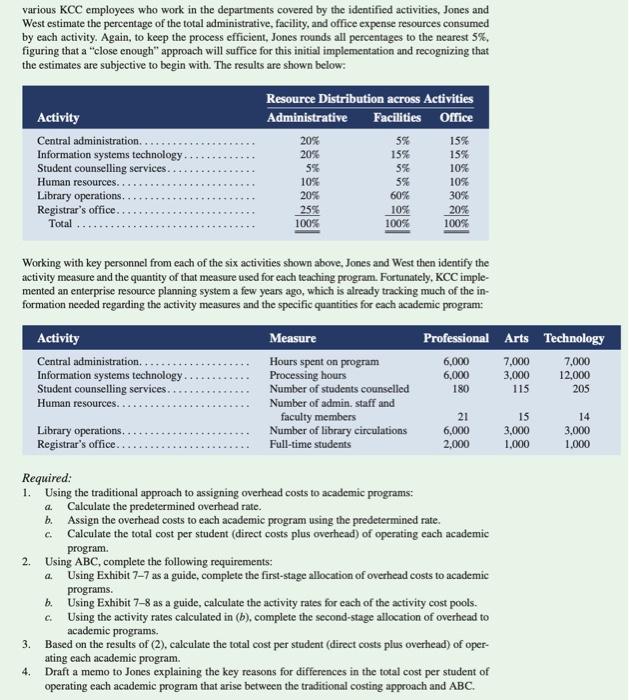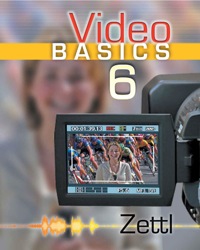CASE 7-26 Comprehensive Activity-Based Costing [LO2, LO3, LOS] Kolbec Commanity College (KCC) has 4,000 fall-time students and effers a variety of academic programs in three areas: professional studies, arts, and technology. The professional studies programs prepare students for administrative and clerical jobs in a variety of professional settings, including accounting, medicine, and law. The arts prognam's offerings are wide ranging and include graphic design, digital animation, culinary arts, cosmetology, and music arts. The techinology programs are also varied, incloding information technology, modical laboratory technology, eloctrical engineering tectinology, pharmacy technology, and natural resources technology. The chief financial officer of KCC., Lynn lones, has consistently emphasized to other members of the senior management team the importance of understunding the costs of delivering the various aca: demic programs. To that end, the costing system used at KCC tracks the direct costs of each program, which are shown below on an annual basis, along with the number of fall-time stodents: It is very important to understand the overhead costs consumed by each academic program at KCC in determining the full cost of eperating the programs. Central administration at KCC allocates financial resources to acadenic programs based on the estimated full seet per studeat of delivering the program. The overhead costs at KCC are significant, totalling over 60 se of direct costs. Total annual overhead costs at KCC are as follow: Traditionally, KCC has allocated ovethead costs to academic programs on the basis of the number of full-time students in each program. This approach was deemed appropriane since Jones reasobed that increasing the number of students at KCC would result in higher overthead costs (e.g., more facilities would be noeded, more indirect support costs would be incurred, etc.). However, Joeses is beginning to question the accuracy of the traditional approash since it results in a similar full cost per student for the arts and technology programs, which she feels doesn't make sense. Based co her knowledge of the programs, Jones foels that tho technology program is probably more expensive to deliver than the arts prognam, but this does not come through in the traditional costing approach. Jones recently attended a seminar on management techniques being used by lending efucational institutions that, among other topics, covered the basics of the ABC approsech. She likes the idea of beiag able to assign indirect costs to academic programs on the basis of how moch of the support activity resources are consumed by cach program. If Jones's instincts are correct in that some programs consume more resources of certain activities than others, this could have a significant impact on the overhead eosts assigned to each under the ABC approach. Upon returning to KCC. Jones decides to implement ABC. Sbe, along with Assistant CFO James West, begins by identifying the key activities used to support the teaching programs. Rather than getting too detailed with respect to identifying activities in the initial implementation, Jones decides to keep the process manageable and comes up with six key activities. Next, based on a series of interviews with various KCC employees who work in the departments covered by the identified activities, Jones and West estimate the percentage of the total administrative, facility, and office expense resources consumed by each activity. Again, to keep the process efficient, Jones roands all percentages to the nearest 5%, figuring that a "close enough" approach will suffice for this initial implementation and recognizing that the estimates are subjective to begin with. The results are shown below: Working with key personnel from each of the six activities shown above, Jones and West then identify the activity measure and the quantity of that measure used for each teaching program. Fortunately, KCC implemented an enterprise resource planning system a few years ago, which is already tracking much of the information needed regarding the activity measures and the specific quantities for each academic program: Required: 1. Using the traditional approach to assigning overhead costs to academic programs: a. Calculate the predetermined overhead rate. b. Assign the overhead costs to each academic program using the predetermined rate. c. Calculate the total cost per student (direct costs plus overhead) of operating each academic program. 2. Using ABC, complete the following requirements: a. Using Exhibit 7-7 as a guide, complete the first-stage allocation of overhead costs to academic programs. b. Using Exhibit 7-8 as a guide, calculate the activity rates for each of the activity cost pools. c. Using the activity rates calculated in (b), complete the second-stage allocation of overhead to academic programs. 3. Based on the results of (2), calculate the total cost per student (direct costs plus overhead) of operating each academic program. 4. Draft a memo to Jones explaining the key reasons for differences in the total cost per student of operating each academic program that arise between the traditional costing approach and ABC








